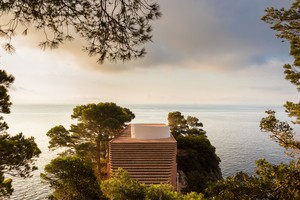
Rudolf Stingel
In July 2017, a special installation of paintings was shown at Casa Malaparte, Capri, the famous house built by the author, publisher, diplomat, and filmmaker Curzio Malaparte.
Winter 2019 Issue
Wyatt Allgeier explores the legacy of Curzio Malaparte and corresponds with the avant-garde author’s youngest descendant, Tommaso Rositani Suckert, on the subject of his decision to reproduce select pieces of furniture from the iconic Casa Malaparte in Capri, Italy.
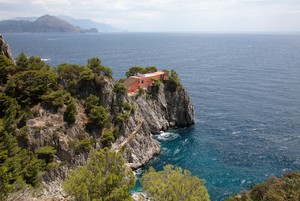
Casa Malaparte, Capri, Italy, 2019. Photo: Sebastiano Pellion di Persano
Casa Malaparte, Capri, Italy, 2019. Photo: Sebastiano Pellion di Persano
You’d be hard pressed to find a more complex, singular, and, frankly, difficult figure to address in the year 2019 than Curzio Malaparte. With a life and an artistic output—collapsed categories for the Italian vanguardist—that consistently defied any systematic ideological or moral program, this novelist, editor, journalist, filmmaker, architect, composer, and general provocateur is a highly knotted subject to try to engage with gracefully—as true in his time as now. His worldview was not made for any type of binary thinking; “paradox” is the most consistent motif in his work. Whether in words, in novels like Kaputt (1944) or La Pelle (The Skin, 1949), or in the singular architecture of his self-designed Casa Malaparte in Capri, the Tuscan visionary had little time for comfortable or safe creations—everything from his hands was a challenge to the preexisting order, a bold offering that succeeds, then and now, in forcing its audiences to reconsider what it means to live in the world.
Born in 1898, as Kurt Erich Suckert (the father of this Italian was German), Malaparte arrived in a world shuttling toward a catastrophic and tumultuous series of wars, revolutions, and technological transformations. Like many artists and writers of the first half of the twentieth century, he served in World War I, left the fighting embittered, and spent the rest of his life questioning what could be responsible for such atrocity. His work after the war as a journalist, novelist, and memoirist—these genres all blurring into one for Malaparte—captures his generation’s distrust of neat demarcations between winning and losing, love and hate, sublimity and horror, loyalty and betrayal. Written in a prose as rich and decadent as anything by J. K. Huysmans, these texts hit you with humor and shock in their amoralism and their raw, unblinking stare at reality.
Malaparte’s personal and political lives were equally paradoxical. In his fifty-nine years, he ricocheted from joining Benito Mussolini’s Fascist party to aligning himself squarely with various Communist parties in Italy and abroad. For a while, he was an atheist; later, he converted back to Catholicism. He deplored Hitler. He was exiled and imprisoned on the island of Lipari by the same Fascists he had supported during his tenure at La Stampa. He worked with the Americans in World War II. He adored Chairman Mao. In La Pelle, he wrote the tenderest possible portrait of the homosexual culture of 1930s and ’40s Europe. He was a womanizer. He started one of Italy’s most prestigious literary and art journals, Prospettive, which featured writing by Søren Kierkegaard, the Comte de Lautréamont, Pablo Picasso, Ezra Pound, and many other top-tier writers, philosophers, and artists of the avant-garde. His allegiances, enemies, and accomplishments go on, but the point is that Malaparte always keeps one at a loss for stable ground from which to judge; he is impossible to sum up, to box in, to label. In this independence of spirit, as well as in a more formal sense, a modernist interest in juxtaposition runs throughout his life, his novels, and his Casa Malaparte: his work is a cubist collage of references, classical, pagan, statist, mechanical, progressive, pastoral, regressive, with no hierarchy made, or at least none kept.
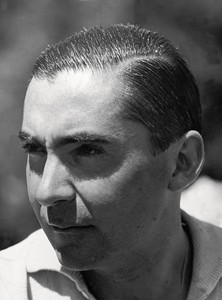
Curzio Malaparte, c. 1920. Photo: Mondadori Portfolio by Getty Images
Malaparte may be a towering figure in Italian and wider European canons of literature and architecture, both for his own work and for his ability to bring together the creators of the time in magazines like 900 and Prospettive, but for most Americans he remains off the standard radars. I admit that I had little knowledge of him until recently, my appreciation for him taking root after I saw photographs of an exhibition staged in the living room of Casa Malaparte. The views of the house left me breathless. Competing with the terrifying beauty of the cliffs of Capri, the satin ocean, and the charm of the local flora, the house maintained a most unlikely presence. It looked classical and modernist all at once. It seemed like a place built for respite, a freedom from civilization, but it had bars on the windows like a prison. The outside stairs led not to the front door but to the roof. It is unlike any other building ever created. Malaparte called it “Casa come me,” a house like me.
The land on which it stands, a majestic cliff face, was purchased by Malaparte in 1937, after his exile at the hands of the fascist state had ended. He originally planned to work with Adalberto Libera, the renowned architect responsible for the rationalization of an Italian Fascist architecture, but the relationship faltered. For someone with Malaparte’s disposition, the work could really only be done by himself. And the result, as the architect Michael McDonough wrote in his ode to the house, is “ultimately a surrealist object, an architecture-poem hybrid, embodying at once the characteristics of a profoundly intelligent, iconic building and a densely literary work.” This character is evident in every square inch of the house and its furniture, all designed and orchestrated by Malaparte himself.
An edition of three of the most iconic furniture pieces from the house will soon be produced by Malaparte’s youngest descendant, Tommaso Rositani Suckert. I met Rositani Suckert soon after seeing the exhibition photographs and began corresponding with him to find out more.
Wyatt AllgeierWho in your family first told you about Curzio Malaparte, and in what context?
Tommaso Rositani SuckertI’ve been aware of Curzio Malaparte for as long as I can remember. As a child, our house was full of writers, translators, publishers, artists, and architects; the name “Malaparte” was often in the air. I was there, in the middle of the living room, crawling around.
When I was eleven, during a summer at Casa Malaparte, my parents had me read “Febo cane metafisico” (Febo, metaphysical dog), a short story about the relationship between Curzio and his dog Febo during his exile in Lipari. My dog at the time was a golden retriever also called Febo. Reading the way Malaparte described his relationship with and love for this animal, and nature more broadly, imprinted on me, even at this young age; I could perceive the intensity of his poetry and the richness of his language.
WADid this idea of re-creating the three pieces of furniture begin while you were at Casa Malaparte?
TRsYes, it was while I was there that I became engaged with the general notion that I wanted to do something that continued the Malaparte legacy. I’ve been going to the house every summer and I used to spend time there in the winters, as well. The winters in particular, when the nature around Capri is wild and tumultuous, were important for my growing appreciation and devotion to the house and legacy. I think being an only child, combined with my parents’ utter devotion to communicating Curzio’s cultural weight, made me want to develop something new relating to my family history. I specifically chose not to just rest on my surname or family history, I wanted to be an active part of it—respecting it and hopefully contributing to a new chapter of it.
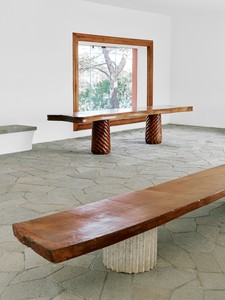
The bench and table at Casa Malaparte. Photo: Thomas Lannes
WAHow did you decide on these three particular pieces? You’re remaking the bench, the table, and the console, correct?
TRSCorrect. I decided to start with those three pieces from the living room of Casa Malaparte because they’re the most recognizable. They’ve been featured in several publications, as well as in iconic scenes from Jean-Luc Godard’s Contempt, filmed at the house in 1963 with Brigitte Bardot, Jack Palance, Michel Piccoli, and Fritz Lang. The pieces also appear in Karl Lagerfeld’s photo book about the house, and have been cited by François Halard and Mario Sorrenti as inspirational. Lastly, I’ve had the pleasure of seeing the furniture exist alongside artworks by Mark Grotjahn, Brice Marden, Ed Ruscha, Rudolf Stingel, and Cy Twombly; that these three furniture pieces were able to exist in dialogue with all of these singular artists convinced me of their poetry.
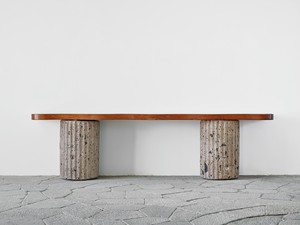
The console at Casa Malaparte. Photo: Thomas Lannes
WAIs this project chiefly your initiative, or do you have partners?
TRSI started on it alone. Then one day my dear friends Henry and Nicholas Burch came for a visit in Florence and we started talking about the house and my idea for the project. It developed casually and we were able to generate great ideas for future developments, so we decided to become partners. What began as a conversation between friends led us into a great team and an amazing synergy motivated by a passion for art and a will to create something timeless. As young entrepreneurs, our challenge is to intertwine Curzio’s historical world and the world of today, keeping his avant-garde vision alive in the future development of our company.
WACould you tell me about the materials? For these three pieces alone, you had to source walnut, Carrara marble, travertine stone, and pine.
TRSThe pine, Carrara white marble, and travertine are 100 percent from Italy. The walnut, because of the thickness of the cut we needed for the table, had to be sourced from around Europe, mostly Italy and Greece.
WAWhere are the pieces being crafted? How did you find the artisan craftspeople to take on such a unique project?
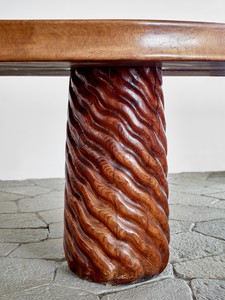
Detail of the table at Casa Malparte. Photo: Thomas Lannes
TRSI’ve been looking for the best cabinetmakers in the north of Italy. Malaparte worked with local people in Capri, particularly the master mason Adolfo Amitrano and his sons, to build the house. I felt it was important to maintain that aspect of the legacy—the reproductions had to fall in the tradition of classic Italian handcraft. But at the same time, we wanted to work with people who had the technology and knowledge to guarantee a top-quality product and an exact reproduction of the original unique pieces. They are, therefore, objects in which the natural processes of wood are consciously taken to the extreme. In the processing and assembly of the furniture, as well as in the finish, we must balance the organic nature of the materials with the required manipulation of them. For each piece, we are producing an edition of twelve, plus two artist’s proofs.
Rositani Suckert’s commitment to upholding the legacy of Malaparte’s prodigious vision, paired with the political, ethical, and aesthetic complexities of the novels, the biography, and the designs, drew me in even further. I couldn’t help thinking that the man and the work offer critical lessons for the present—perhaps 2019 is in fact a great moment to consider this mischievous, bold renegade known as Malaparte. Exposure to Malaparte’s books, home, furniture, and life provides guideposts for us to think about the limits of art, the danger of intermixing beauty and politics, the messiness of our own histories and lives, and the wonder of new temporal configurations. That we are able to explore these lines of thought is not just a privilege, but increasingly an ethical necessity. A “house like him” contains many doors, windows, fireplaces, steps, tables, benches, consoles, and beds that may serve us well to build a more honest house for and like ourselves.
For more information on Tommaso Rositani Suckert’s project, visit: www.malaparte.us
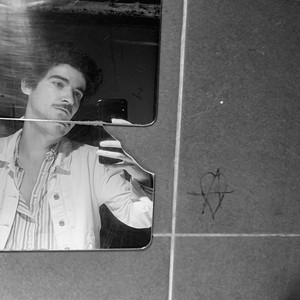
Wyatt Allgeier is a writer and an editor for Gagosian Quarterly. He lives and works in New York City.

In July 2017, a special installation of paintings was shown at Casa Malaparte, Capri, the famous house built by the author, publisher, diplomat, and filmmaker Curzio Malaparte.
Featuring interviews with Tommaso Rositani Suckert and Serena Cattaneo Adorno, this video presents a unique look at the history of Casa Malaparte in Capri and documents the fabrication of new editions of the iconic furniture pieces from the house, designed in the late 1930s by avant-garde writer Curzio Malaparte.
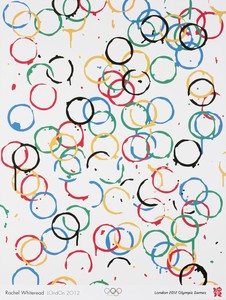
The Olympic and Paralympic Games arrive in Paris on July 26. Ahead of this momentous occasion, Yasmin Meichtry, associate director at the Olympic Foundation for Culture and Heritage, Lausanne, Switzerland, meets with Gagosian senior director Serena Cattaneo Adorno to discuss the Olympic Games’ long engagement with artists and culture, including the Olympic Museum, commissions, and the collaborative two-part exhibition, The Art of the Olympics, being staged this summer at Gagosian, Paris.

David Cronenberg’s film The Shrouds made its debut at the 77th edition of the Cannes Film Festival in France. Film writer Miriam Bale reports on the motifs and questions that make up this latest addition to the auteur’s singular body of work.

On the occasion of Art Basel 2024, creative agency Villa Nomad joins forces with Ghetto Gastro, the Bronx-born culinary collective by Jon Gray, Pierre Serrao, and Lester Walker, to stage the interdisciplinary pop-up BRONX BODEGA Basel. The initiative brings together food, art, design, and a series of live events at the Novartis Campus, Basel, during the course of the fair. Here, Jon Gray from Ghetto Gastro and Sarah Quan from Villa Nomad tell the Quarterly’s Wyatt Allgeier about the project.

Founded in 1998 by Issey Miyake, A-POC (“A Piece of Cloth”) set out to bring the development and production of fabric and garments into the future. Over the subsequent decades, A-POC has worked at the forefront of technology to realize its goals, and under the leadership of Yoshiyuki Miyamae—who has been with Miyake Design Studio since 2001—A-POC ABLE has engaged in a dynamic series of collaborations with artists, architects, craftspeople, and new technologies to rethink how clothing is designed and made. On the occasion of the line being made available in the United States for the first time, the Quarterly’s Wyatt Allgeier visited the brand’s flagship in New York to speak with Yoshiyuki about the A-POC process, as well as the latest collaboration with the artist Sohei Nishino.

Art for a Safe and Healthy California is a benefit exhibition and auction jointly presented by Jane Fonda, Gagosian, and Christie’s to support the Campaign for a Safe and Healthy California. Here, Fonda speaks with Gagosian Quarterly’s Gillian Jakab about bridging culture and activism, the stakes and goals of the campaign, and the artworks featured in the exhibition.

An interview with Marcantonio Brandolini d’Adda, artist, designer, and CEO and art director of the Venice-based glassware company Laguna~B.

The mind behind some of the most legendary pop stars of the 1980s and ’90s, including Grace Jones, Pet Shop Boys, Frankie Goes to Hollywood, Yes, and the Buggles, produced one of the music industry’s most unexpected and enjoyable recent memoirs: Trevor Horn: Adventures in Modern Recording. From ABC to ZTT. Young Kim reports on the elements that make the book, and Horn’s life, such a treasure to engage with.

Louise Gray on the life and work of Éliane Radigue, pioneering electronic musician, composer, and initiator of the monumental OCCAM series.

Tracing the history of white noise, from the 1970s to the present day, from the synthesized origins of Chicago house to the AI-powered software of the future.

In celebration of the life and work of Frank Stella, the Quarterly shares the artist’s last interview from our Summer 2024 issue. Stella spoke with art historian Megan Kincaid about friendship, formalism, and physicality.